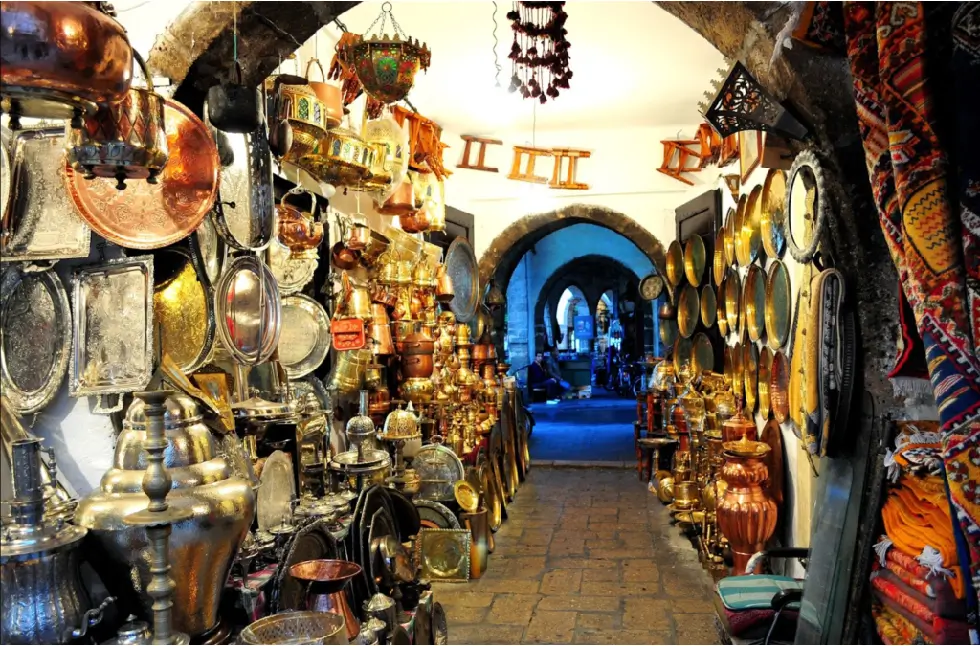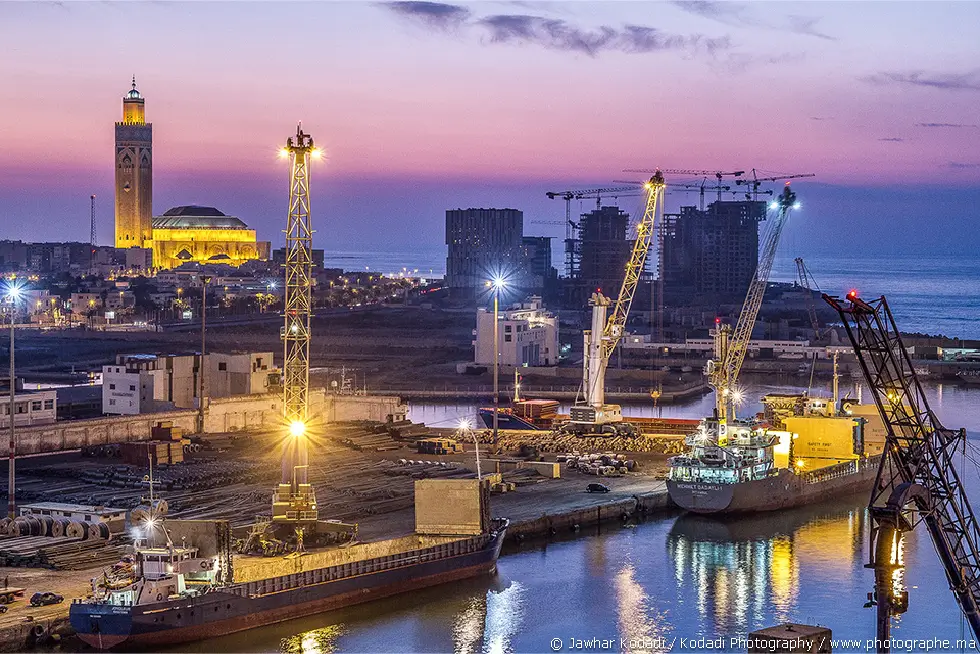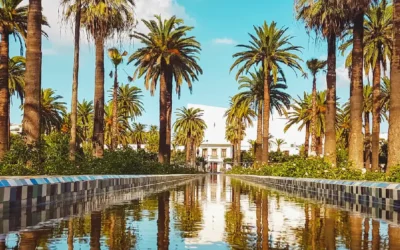Casablanca The Biggest City In Morocco

Table of Contents:
Introduction to Casablanca City
Casablanca, the biggest city in Morocco, considered the economic capital city, positioned as Morocco’s principal port on the North African Atlantic seaboard, unfolds a rich history dating back to the 12th century. Originally a Berber village named Anfa.
its narrative has been sculpted by various rulers including the Portuguese and French, the latter of whom significantly modernized the city during the early 20th century.
This metamorphosis catapulted Casablanca into becoming the nerve center of Morocco’s economy, with its port playing a crucial role in the nation’s foreign trade. The city now stands as a bustling metropolis.
Its unique architectural and cultural blend, coupled with its economic prominence, magnetizes a spectrum of visitors, including business travelers and tourists, making Casablanca not only a commercial powerhouse but also a fascinating rendezvous of the old and the new.
Geographical Location Of Casablanca
Casablanca is a coastal city in Morocco, situated near the Atlantic Ocean, on a flat area known as the Chaouia Plain. It’s specifically located 95 kilometers (or 59 miles) southwest of Morocco’s capital, Rabat. This city is not only a key location within Morocco but also in North Africa, being part of a region known as the Maghreb.

The Maghreb is a part of North Africa that includes several countries like Morocco, Algeria, and Tunisia. Casablanca’s location near the ocean and its closeness to Rabat make it a notable spot in this part of North Africa. So, when you look at a map, you’ll find Casablanca on the western edge of Morocco, making it a significant city in the Maghreb region of North Africa.
The Local Lifestyle In Casablanca
Casablanca is a vibrant city in Morocco where the charm of the old intertwines with the pulse of the new. As you wander through its streets, the lively markets burst with colors and tradition. Here are some noteworthy spots:
1. New Medina

This area is a delightful blend of traditional Moroccan aesthetics and contemporary European vibes. Here, shopping is an adventure with both indoor boutiques and outdoor markets awaiting your exploration.
2. Central Market

An absolute haven for food enthusiasts! Along with delectable food, this market also offers handmade crafts and everyday essentials.
3. Habous Olive Market

A marketplace dedicated to olives in all forms. It’s the locals’ favorite spot for stocking up, and grabbing some olive oil to take home is a must.
4. Maarif Market

A kaleidoscope of fresh fruits, vegetables, spices, and other local produce, this market is a burst of colors and flavors.
5. Marche des Boucheries

For meat lovers, this place is a treasure. Offering a variety of meats, including live chickens, it’s a glimpse into the traditional meat market scene.
6. Derb Ghallef Flea Market

A massive second-hand market where the hunt for treasures ranges from inexpensive electronics to vintage apparel.
7. The Old City (Medina)

Step into a timeless maze of narrow streets, where every turn leads to quaint shops, traditional eateries, and an abundance of Moroccan culture awaiting to be discovered.
These markets are more than just shopping hubs; they are windows into the daily lives of Casablanca’s inhabitants, showcasing the city’s local culture in a vibrant display.
Beyond the markets, the modern side of Casablanca beckons with chic beach clubs and exquisite restaurants, particularly in areas like Ain Diab, where the beach is the perfect backdrop for a relaxing day.
The city’s rich crafting tradition is a testimony to its cultural heritage. Local craftsmen, using simple tools, conjure beautiful creations ranging from jewelry and furniture to clothing. It’s this fascinating meld of the old and the new that renders Casablanca a unique and enchanting place to explore.
Transportation Network Infrastructure
Casablanca offers several transportation options, making it easy to travel within the city and to other parts of Morocco and beyond. Here are some suggestions:
1. Trams

Casablanca has a tram service called Casa Tramway. It’s known for being clean, safe, and comfortable. The tram network is extensive with over 70 stops throughout the city, and a single ride costs 6 dirhams.
Currently, there are two main tram lines, T1 and T2. There were plans to introduce two more lines, T3 and T4, by 2022 to make traveling within the city even more convenient.
2. Buses

There’s a bus service known as the Casablanca Busway which is designed to complement the tram service, making it easier for people to move around the city.
Additionally, there were plans to add two quick bus routes by 2022 to make bus travel faster within the city.
3. Trains

For longer trips, there’s a fast train called Albouraq that travels at a speed of 320 km / h, 199 Miles / h, which connects between Casablanca and Tangier. This is part of a bigger project to introduce many more train lines in Morocco by 2035. The fast train has a lot of seats and is expected to be a popular choice, helping millions of travelers each year.
So, whether you’re exploring Casablanca or heading to other cities, you have a variety of transportation choices!
Places To Explore In Casablanca
Casablanca hosts a variety of attractions for tourists. Some of the notable places and activities include:
1. Hassan II Mosque

Standing as Morocco’s largest mosque and one of the biggest globally, this architectural gem towers nearly seven hundred feet and welcomes visitors with daily tours at designated times.
2. The Medina

Step into Casablanca’s ancient heart, a walled city filled with a winding labyrinth of marketplaces and streets. Don’t miss the iconic clock tower at the entrance as you soak up the locale’s bygone lifestyle.
3. La Corniche

Stretching from the Hassan II Mosque to the Ain Diab district, this beachfront area is a haven for resort lovers, offering a scenic seaside stroll.
4. Place Mohamed V Square

Located in the city’s modern quarter, this spot is a blend of luxury and comfort. Capture the essence of Casablanca with your camera amidst fountains, palm trees, pigeons, and towering corporate offices.
5. Ain Diab Beach

Casablanca’s answer to Miami, this tranquil beach boasts shimmering sands and clear waters. It’s a paradise for beach bums, with plenty of eateries to satisfy your cravings.
6. City Tours

From cultural to architectural tours, explore the city’s rich tapestry in various comprehensive guided tours. Whether you’re into history, religion, or architecture, there’s something to pique your curiosity.
7. Retail and Relaxation

Indulge in some shopping, catch a game, or unwind at a spa. Casablanca’s malls, sporting events, and spa facilities are perfect for those looking for a leisurely day.
8. Nature, Maritime, and Historical Tours
Delve deeper into Casablanca’s abundant natural, maritime, and historical treasures through specialized tours, uncovering the city’s layered heritage.
9. Extended Adventures
If you’re keen on venturing beyond the city, private day trips, overnight tours, and transfer services are available to ensure smooth travels and broader exploration.
Casablanca is a treasure trove of experiences, whether you’re a history buff, an architecture enthusiast, or someone who just wants to laze by the beach. The city’s blend of traditional and contemporary offerings promises a fulfilling adventure for every visitor.
Casablanca The Economic Capital City Of Morocco
Casablanca isn’t just a classic movie, it’s also the heartbeat of Morocco’s economy. This bustling city is where business happens—it’s home to over half of the country’s factories and a hotbed for commerce and investment. When you talk about finance, trade, and manufacturing in Morocco, you’re talking about Casablanca. The city has even coined its own financial district, the Casablanca Finance City, marking its ambition to be the financial nexus not just for Morocco, but for Africa.

But what really puts Casablanca on the map is its port. The Port of Casablanca is a marvel in its own right—it’s one of the largest artificial ports in the world. This isn’t just a parking lot for ships; it’s the gateway for 35% of Morocco’s foreign trade. The port is like the city’s cashier counter, handling 86% of all containers that come in and out of the country.

And guess what? They’re scaling up. A third terminal is being added to the port to double its capacity. This means it can handle up to 3.3 million TEUs (that’s Twenty-Foot Equivalent Units, a measure of cargo capacity) a year. This expansion isn’t just a one-off; it’s a long-term play with Marsa Maroc being handed a 30-year concession to manage this new terminal.
Casablanca and Tangier are the welcoming decks of Morocco for foreign goods. With ferry services between Morocco and Spain, it’s a smooth sail for goods to be trucked in and out. The Port of Casablanca isn’t an island; it’s well connected to the city and beyond with its own 17 km railway network.
In the business world, meetings, incentives, conferences, and exhibitions (MICE) are where deals are made and partnerships are forged. Casablanca is carving a niche for itself as a go-to destination for business tourism. With increased air connectivity and a growing roster of conference and entertainment venues, the city is all set to host professionals from across the globe.
All in all, Casablanca isn’t just a historic city with a rich heritage; it’s a dynamic economic hub that’s powering Morocco into the future. Through its port, it’s not only connecting Morocco to the world but also creating a fertile ground for business to thrive within its borders.
Exploring The Architecture Of Casablanca
Casablanca, a big city in Morocco, its architecture has a mix of cool old and new building styles. It’s known for its old-school buildings from the time when the French were around. There’s a unique style called Mauresque in Casablanca, which mixes local Moroccan and European designs, giving buildings a fancy and unique look.

One of the standout buildings in Casablanca is the Hassan II Mosque. This mosque is awesome because it brings a fresh spin to old-style art. A lot of the materials used to build the mosque came from Morocco itself, and many skilled local workers spent five years making beautiful designs inside and out.

The design of the Hassan II Mosque blends Islamic, Moroccan, and a bit of European styles, creating a cool mix of old and new ideas. The way the mosque is laid out is different from many others in North Africa, making it special. It’s a massive place, with room for a whopping 25,000 people in the main prayer hall and 80,000 more in the surrounding open areas. This huge mosque is not only a sight to behold but also a big part of what makes Casablanca unique.
A Historical Glimpse Of Casablanca
The story of Casablanca, a city in modern-day Morocco, goes way back to the 12th century when it was a small village called Anfa, home to the Berber people. But by the 15th century, pirates had made it their base, which led to trouble. The Portuguese attacked and destroyed it in 1468, but then came back to live there in 1515. However, a big earthquake in 1755 destroyed the place again.
Then, in the late 18th century, a leader named Sultan Sīdī Muhammad ibn ʿAbd Allāh decided to rebuild the town, with some help from Spanish people. Spanish traders started calling the place Casa Blanca, which means “White House” in Spanish, and that name stuck around. In Arabic, it’s called “ad-Dār al-Bayḍāʾ”.
In the early 20th century, the French came and took control of Casablanca. During the time they were in charge, from 1912 to 1956, the city grew a lot and became the main port of Morocco.
During World War II, an important meeting happened in Casablanca in January 1943. This meeting, known as the Casablanca Conference, had big leaders like U.S. President Franklin D. Roosevelt and British Prime Minister Winston Churchill. They met to plan what to do next in the war.
So, from a small village to a pirate base, and from ruins to a growing city, Casablanca has seen a lot. Each part of its story, from the times of pirates and Portuguese, through its rebuilding, the French control, and its part in World War II, shows how much Casablanca has changed over the centuries.
Conclusion
Casablanca, a gem on Morocco’s Atlantic coast, invites visitors to explore its unique blend of historical allure and modern vibrancy. The city boasts architectural marvels like the Hassan II Mosque alongside bustling markets that offer a taste of its rich cultural tapestry. Whether you’re drawn to its historical narratives, economic buzz, or the enthralling fusion of traditional and contemporary lifestyles, Casablanca promises an enriching voyage of discovery. Its welcoming shores are more than just a gateway for Morocco’s trade; they’re a gateway to an unforgettable adventure in a city where the charm of the old gracefully dances with the pulse of the new.
FAQ
What is the historical background of Casablanca?
Casablanca, dating back to the 12th century, was initially a Berber village named Anfa. Over the centuries, it saw rule by Portuguese and French, the latter significantly modernizing the city during the early 20th century. Significant events like the Casablanca Conference during World War II also mark its historical narrative.
What are the transportation options within Casablanca?
Casablanca has a variety of transportation options including trams (Casa Tramway), buses (Casablanca Busway), and a fast train service between Casablanca and Tangier. There were plans to expand tram and bus services further.
What are some notable markets in Casablanca?
Casablanca hosts vibrant markets like New Medina, Central Market, Habous Olive Market, Maarif Market, and Derb Ghallef Flea Market, each offering a unique glimpse into the local culture and a variety of goods ranging from fresh produce to handmade crafts.
Where is Casablanca located?
Casablanca is a coastal city located near the Atlantic Ocean on the Chaouia plain, 95 kilometers southwest of Morocco’s capital, Rabat. It is a significant city in the Maghreb region of North Africa.
What makes Casablanca a unique destination?
Casablanca’s blend of historical charm, modern vitality, economic significance, and architectural marvels make it a unique destination, offering a blend of traditional and contemporary experiences to visitors.
What are some must-visit places in Casablanca?
Tourists can explore the Hassan II Mosque, The Medina, La Corniche, Place Mohamed V, and Ain Diab Beach, and partake in various city tours exploring the city’s rich historical and architectural heritage.
Why is Casablanca considered the economic hub of Morocco?
Casablanca is home to over half of Morocco’s factories and a significant portion of its financial and trading activities. The Port of Casablanca handles 35% of Morocco’s foreign trade and 86% of container traffic, making it a cornerstone of the nation’s economy.
What steps are being taken to enhance the Port of Casablanca?
A third terminal is being added to the port to double its capacity to 3.3 million TEUs (Twenty-Foot Equivalent Units) per year. Marsa Maroc has been given a 30-year concession to manage this new terminal, reflecting a long-term strategy to bolster trade and commerce.
What architectural styles are predominant in Casablanca?
Casablanca showcases a blend of Moroccan and European architectures, with a unique style called Mauresque. Notable architectural landmarks include the Hassan II Mosque, which beautifully melds Islamic, Moroccan, and European styles.



